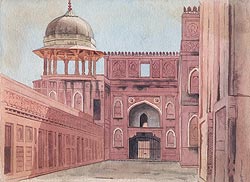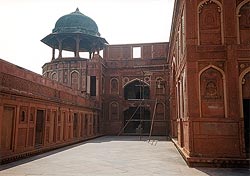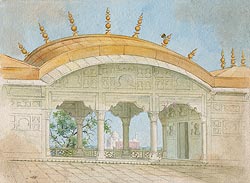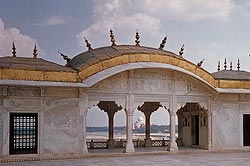After Meerut
| Agra Fort - The Gaol. (Click to enlarge) |
Photo taken in 1997. (Click to enlarge) |
On leaving Meerut the 31st Regiment moved to Ghazeepore, and then Agra, both long established for British troops. The distance between them was about six weeks march through good sporting country. Peafowl, partridges, quail and hares were plentiful, and the ponds and lakes swarmed with wildfowl. Shooting parties were formed every day after completing the march, and Greenwood wrote that “whole hecatombs of game fell before our Mantons and Purdeys” -those highly reputed English gunmakers.
Ghazeepore was on the Ganges and evoked memories of Dinapore. It was just as unhealthy, and the soldiers’ accommodation was no better except that senior NCOs were provided with bungalows. The officers were able to obtain detached bungalows, each with a large compound, which they much preferred to living in barracks even though the bungalows leaked during the rainy season and were infested by snakes and rats. Great quantities of roses were grown in the area for the production of rose water and scent. There were also many mango trees and pineapples. Thousands of every kind of wildfowl were to be found on the numerous lakes, and Greenwood built punts from which to hunt them. He also obtained a swivel-gun from England which caused no little havoc among the wild duck. The area was also famous for its highly skilled thieves, and he told one story about a fat sergeant and his family losing their bedclothes while they slept which was accomplished by the gentle application of a feather on their noses to persuade them to roll over so that the sheets could be pulled away.
| The Golden Pavilions
- One of a pair at Agra Fort, Royal Palace. Taj Mahal visible in distance. (Click to enlarge) |
Photo taken by Mrs Mary Pink, daughter of the artist in 1997. (Click to enlarge) |
The regiment arrived in Agra in 1840. The place was the seat of government for the North Western Province of the Bengal Presidency, and the cantonments were extensive. They accommodated a British regiment, three Indian regiments, and artillery. The area was of particular interest because of the magnificent fort, the beauty of the Taj Mahal, and the ruins of the deserted palaces of the once lordly Moguls. The ruins were infested by wolves which were apt to prowl among the cantonments at night and carry away small children, and there was a reward of ten rupees for any person who brought a wolf’s head to the magistrate. The year before there had been a great famine, and thousands of deaths from starvation. Whole villages had become depopulated; many peasants wandered about the country, and being unable to obtain food, offered their children for sale. European residents had created a relief fund to provide food, and had established a depot at Agra to care for the unfortunate offspring.
The Regiment’s stay was curtailed when it was ordered to Afghanistan, but before it left the officers attended an entertainment provided by the Rajah of Bhurtpore for the European residents of Agra. Two hundred guests sat down to dinner in the European style under large handsomely carpeted tents pitched near the fort, and were entertained afterwards by dancing girls, native music and a firework display which Greenwood considered “well worth seeing, although undoubtedly inferior to what I have seen as a boy at Vauxhall Gardens.” Another of his recollections of Agra was of “an establishment for collecting a stock of ice in the cold weather, sufficient to last for the three hottest months succeeding it. A number of square pits were dug about three foot deep; these were nearly filled with a thick layer of straw, and upon this were placed a number of small flat earthen saucers, into each of these was poured a little water every night, and in the morning, before break of day, there was generally a thin sheet of ice formed in each saucer. This was collected by coolies employed for the purpose, who lived in villages adjoining and were assembled every morning by the beat of a large drum. It was then placed in the ice house, which was a pit with a mud wall raised around the mouth and thatched over”.
Related




